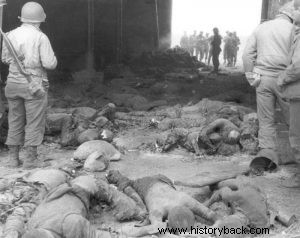
Gardelegen is a small town in the present-day state of Saxony-Anhalt in eastern Germany. In the second week of April 1945, however, the war had reached the once peaceful city. Pressured by the Allies, the German army was retreating trying to cover up its horrific crimes. The Mittelbau-Dora concentration camp, an annex of the infamous Buchenwald, and the Hanover-Steken camp were also evacuated in this attempt. Escorted by SS guards 1,016 ill-fated slave prisoners of the two camps were transported west. Most of them were Poles, but there were also Soviets and some Westerners.
When the prisoners and their guards arrived at Gardelegen on April 13, 1945, three days before the Battle of Berlin began, the SS decided that they had to "get rid" of the prisoners. Because they themselves were few, they also asked for help from local Volkssturm militiamen, children of the Hitler Youth, residents, and even firefighters and after leading the prisoners to a warehouse, nailed the doors, covered the building with gasoline and set it on fire!
The unfortunate prisoners tried to fight back, but those who tried to get out of the burning warehouse were shot without mercy. The Germans, being typical gentlemen, intended to cover up, the next day, the traces of the crime, burning what was left of people and warehouse. Indeed the killers gathered on April 14 at the scene of the crime to destroy the remains and eliminate the traces.
But luck wanted otherwise. Thus Company F of the 2nd Battalion of the US 405th Infantry Regiment of the 102nd Infantry Division entered the city on the same day. The Germans abandoned their plan and were magically transformed from beasts to peaceful citizens, to pure children, to ordinary firefighters. However, the Americans, investigating the area, reached the still smoking ruins of the warehouse and discovered the crime. They even found 11 survivors (seven Poles, one French and three Soviets) who miraculously escaped.
On April 21, the Americans forced the German residents to collect the bodies of their victims and bury them properly. A total of 1,016 bodies were buried. The Americans also erected a rough monument in honor of the murdered. At the same time, investigations were started on the attribution of responsibilities. In the end, however, only one German paid, SS lieutenant Erhard Brauni who was tried in 1947, sentenced to life in prison and died in 1950. The nameless, murderous German mob, otherwise clueless about Hitler's crimes, did not pay.



